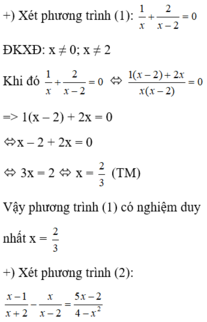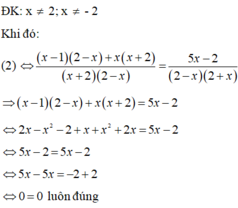
Hãy nhập câu hỏi của bạn vào đây, nếu là tài khoản VIP, bạn sẽ được ưu tiên trả lời.


a) \(\left(4x-10\right)\left(24+5x\right)=0\)
\(\Leftrightarrow\orbr{\begin{cases}4x-10=0\\24+5x=0\end{cases}}\)
\(\Leftrightarrow\orbr{\begin{cases}x=\frac{5}{2}\\x=-\frac{24}{5}\end{cases}}\)
Vậy tập nghiệm của phuwong trình là : \(S=\left\{\frac{5}{2};-\frac{24}{5}\right\}\)
b) \(\left(2x-1\right)^2+\left(2-x\right)\left(2x-1\right)=0\)
\(\Leftrightarrow\left(2x-1\right)\left(2x-1+2-x\right)=0\)
\(\Leftrightarrow\left(2x-1\right)\left(x+1\right)=0\)
\(\Leftrightarrow\orbr{\begin{cases}2x-1=0\\x+1=0\end{cases}}\)
\(\Leftrightarrow\orbr{\begin{cases}x=\frac{1}{2}\\x=-1\end{cases}}\)
Vậy tập nghiệm của ptr là : \(S=\left\{\frac{1}{2};-1\right\}\)



Vậy phương trình (2) có vô số nghiệm.
Do đó phương trình (2) có nhiều nghiệm hơn phương trình (1)
Chọn đáp án C

a. (4x−10)(24+5x)=0⇔4x−10=0(4x−10)(24+5x)=0⇔4x−10=0 hoặc 24+5x=024+5x=0
+ 4x−10=0⇔4x=10⇔x=2,54x−10=0⇔4x=10⇔x=2,5
+ 24+5x=0⇔5x=24⇔x=−4,824+5x=0⇔5x=24⇔x=−4,8
Phương trình có nghiệm x = 2,5 và x = -4,8
b. (3,5−7x)(0,1x+2,3)=0⇔3,5−7x=0(3,5−7x)(0,1x+2,3)=0⇔3,5−7x=0hoặc 0,1x+2,3=00,1x+2,3=0
+ 3,5−7x=0⇔3,5=7x⇔x=0,53,5−7x=0⇔3,5=7x⇔x=0,5
+ 0,1x+2,3=0⇔0,1x=−2,3⇔x=−230,1x+2,3=0⇔0,1x=−2,3⇔x=−23
Phương trình có nghiệm x =0,5 hoặc x = -23

\(a,\)
\(2x^2-5x-7=0\)
\(\Leftrightarrow2x^2+2x-7x+7\)
\(\Leftrightarrow2x\left(x+1\right)-7\left(x+1\right)=0\)
\(\Leftrightarrow\left[{}\begin{matrix}x+1=0\\2x-7=0\end{matrix}\right.\)
\(\Leftrightarrow\left[{}\begin{matrix}x=-1\\x=\dfrac{7}{2}\end{matrix}\right.\)
\(\left(2x+2\right)\left(x+\dfrac{7}{2}\right)=0\)
\(\Leftrightarrow\left[{}\begin{matrix}2x+2=0\\x+\dfrac{7}{2}=0\end{matrix}\right.\)
\(\Leftrightarrow\left[{}\begin{matrix}x=-1\\x=-\dfrac{7}{2}\end{matrix}\right.\)
Vậy 2 pt ko tương đương
\(b,\left(2x-3\right)\left(x^2-4\right)=0\)
\(\Leftrightarrow\left[{}\begin{matrix}2x-3=0\\x^2-4=0\end{matrix}\right.\)
\(\Leftrightarrow\left[{}\begin{matrix}x=\dfrac{3}{2}\\x=\pm2\end{matrix}\right.\)
\(6x^2=24\Leftrightarrow x^2=4\Leftrightarrow x=\pm2\)
Vậy 2 pt tương đương
a: 2x^2-5x-7=0
=>2x^2-7x+2x-7=0
=>(2x-7)(x+1)=0
=>x=7/2 hoặc x=-1
(2x+2)(x+7/2)=0
=>(x+1)(x+7/2)=0
=>x=-7/2 hoặc x=-1
=>Hai phương trình ko tương đương
b: (2x-3)(x^2-4)=0
=>(2x-3)(x-2)(x+2)=0
=>\(x\in\left\{\dfrac{3}{2};2;-2\right\}\)
6x^2=24
=>x^2=4
=>x=2 hoặc x=-2
=>Hai phương trình ko tương đương


\(4x\left(x-1\right)+5\left(1-x\right)=0\)
\(\Leftrightarrow4x\left(x-1\right)-5\left(x-1\right)=0\)
\(\Leftrightarrow\left(4x-5\right)\left(x-1\right)=0\)
\(\Leftrightarrow\orbr{\begin{cases}4x-5=0\\x-1=0\end{cases}}\)
\(\Leftrightarrow\orbr{\begin{cases}x=\frac{5}{4}\\x=1\end{cases}}\)

Ta có : 2x4 - 5x3 + 4x2 -5x +2 =0
<=> ( 2x4 +4x2 +2) - ( 5x3 + 5x)=0
<=> 2( x4+2x2+1) - 5x( x2 +1) =0
<=> 2 ( x2+1)2 - 5x( x2+1) =0
<=> (x2 +1) ( 2( x2 +1) -5x ) =0
<=> 2( x2 +1) -5x =0 ( vì x2 >_ 0 => x2 +1 >0)
<=>2x2 +2 -5x =0
<=> 2x2 +2 -4x-x =0
<=> (2x2 -4x) +( 2-x) =0
<=> 2x(x-2) -( x-2) =0
<=> (x-2) (2x-1) = 0
<=> x-2 =0 <=> x= 2 hoặc 2x-1 =0 <=> x= 1/2
vậy x= 2 hoặc x= 1/2
- học tốt -

1
a (9+x)=2 ta có (9+x)= 9+x khi 9+x >_0 hoặc >_ -9
(9+x)= -9-x khi 9+x <0 hoặc x <-9
1)pt 9+x=2 với x >_ -9
<=> x = 2-9
<=> x=-7 thỏa mãn điều kiện (TMDK)
2) pt -9-x=2 với x<-9
<=> -x=2+9
<=> -x=11
x= -11 TMDK
vậy pt có tập nghiệm S={-7;-9}
các cau con lai tu lam riêng nhung cau nhan với số âm thi phan điều kiện đổi chiều nha vd
nhu cau o trên mk lam 9+x>_0 hoặc x>_0
với số âm thi -2x>_0 hoặc x <_ 0 nha
\(5x-2x-24=0\)
\(3x=24\)
\(x=8\)
hok tốt!!
5x-2x-24=0
5x-2x=0+24
3x=24
x=8
vậy pt có nghiệm là 8